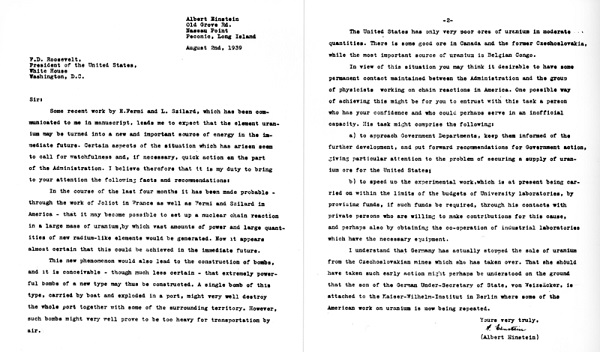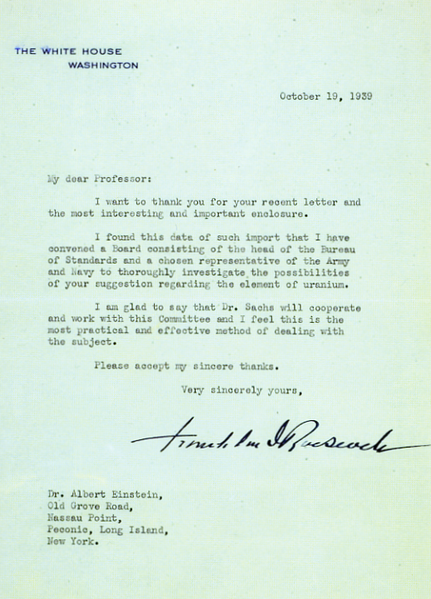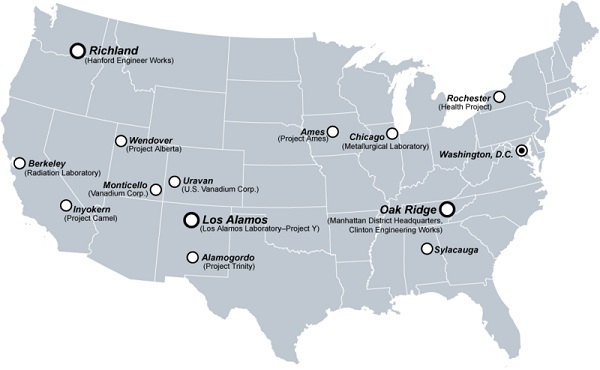The history of the atomic bomb presents one of the most intriguing and gut-wrenching moral dilemmas. In the 1940s, the world was at war. Fascism presented a threat to most of the world and our way of life. The United States put its best nuclear scientists to work to invent a weapon that would change the course of the war, and do it before any of the enemies did. The success of the Manhattan Project turned into the horror for Hiroshima and Nagasaki. What do we make of this incredible scientific breakthrough that ended World War II but caused the death and suffering of so many of the Japanese people?
In 1939, before the United States entered the war, Albert Einstein was persuaded by fellow scientists to write a letter to President Roosevelt that identified the possibility of creating a super weapon.
In the course of the last four months it has been made probable - through the work of Joliot in France as well as Fermi and Szilard in America - that it may become possible to set up a nuclear chain reaction in a large mass of uranium, by which vast amounts of power and large quantities of new radium-like elements would be generated. Now it appears that almost certain that this could be achieved in the immediate future.
In other words, uranium could be used to create a huge bomb. In 1940, $6000 was made available to scientists to start research on the project that would become known as the Manhattan Project. It was known that German scientists were also working on such a project as were British scientists. US scientists collaborated with their British counterparts, and a number of scientists contributed to the simultaneous lines of research that had to be carried out for the project to be a success.
By the summer of 1945 the original $6000 for the Manhattan Project had turned into $2 billion, and the necessary materials had been and research had been put together to produce an atomic explosion. On July 16, 1945 the first atomic test was performed in the desert of New Mexico. The explosion was more powerful than anyone could have imagined. America officially had the bomb. Now what?
By this time in 1945, Germany had already surrendered and the allies had made many advances against Japan. On July 26, 1945 a broadcast was sent by the Allies to Japan demanding their unconditional surrender. This was known as the Potsdam Proclamation. In it, there was no mention or threat of the atomic bomb, but Japan refused to surrender. President Truman, who had only been in office for a few months, had a decision to make. The common wisdom was that to defeat Japan it would take a massive invasion and it would cost perhaps a million lives of Allied soldiers. No one will ever know what anguish Truman went through, as a President is truly alone in making such decisions. On August 6, the first atomic bomb was dropped on the people of Hiroshima and a second was dropped on Nagasaki on August 9. The following is an excerpt from Truman's speech.
Sixteen hours ago an American airplane dropped one bomb on Hiroshima and destroyed its usefulness to the enemy. That bomb had more power than 20,000 tons of TNT. It had more than two thousand times the blast power of the British "Grand Slam" which is the largest bomb ever yet used in the history of warfare.
…
It was to spare the Japanese people from utter destruction that the ultimatum of July 26 was issued at Potsdam. Their leaders promptly rejected that ultimatum. If they do not now accept our terms they may expect a rain of ruin from the air, the like of which has never been seen on this earth. Behind this air attack will follow sea and land forces in such number that and power as they have not yet seen and with the fighting skill of which they are already well aware.
Something like 70,000 people perished immediately in Hiroshima and 80,000 in Nagasaki. Many 100s of thousands later became sick from radiation poisoning. Through all the madness, the atomic bomb accomplished its goal. No Allied invasion would be carried out, as Japan surrendered on August 14.
After the war, nuclear weapons because part of our daily fears. The Soviet Union developed the bomb as well as a number of other nations, some friendly to us and some not so much. The Cold War went on but thankfully mutually assured destruction (MAD) has kept any leader from being insane enough to use a nuclear weapon. During the Cuban Missile Crisis, the world came very close to nuclear annihilation. In the 13 day standoff, Kennedy and Khrushchev took the world to the brink but thankfully cooler heads prevailed and the weapons were not used.
Today we have North Korea making threats to use their nuclear weapons against the United States, and Iran marching ahead to develop a nuclear weapon. It's no longer the 2 superpowers agreeing not to destroy the earth with their 1000s of weapons, but a few rogue troublemaker nations.
I have a personal connection with the decision to use the bomb in that my father was a soldier in 1945 and most likely would have been part of the Japan invasion had the bomb not been used. Had my father not returned, I would never have been born.
The Manhattan Project brought the world for the first time the ability for humans to destroy the world we live in. Perhaps it is the memories of Hiroshima and Nagasaki and the knowledge that those weapons today are far worse that keeps the leaders of the world from ever using them again.














SUBMIT A COMMENT